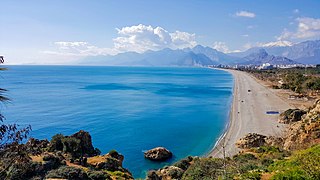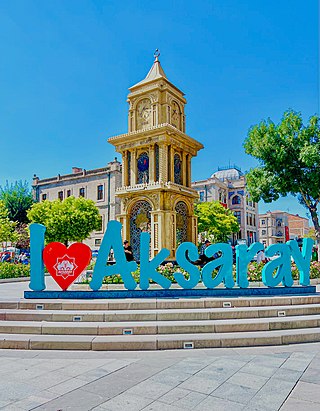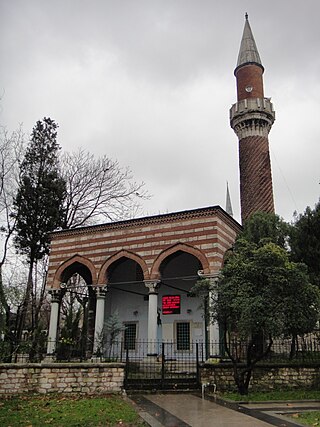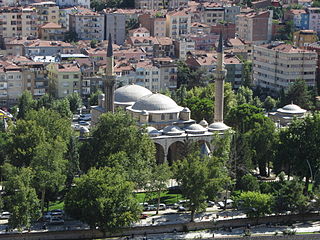
A minaret is a type of tower typically built into or adjacent to mosques. Minarets are generally used to project the Muslim call to prayer (adhan) from a muezzin, but they also served as landmarks and symbols of Islam's presence. They can have a variety of forms, from thick, squat towers to soaring, pencil-thin spires.

The Blue Mosque in Istanbul, also known by its official name, the Sultan Ahmed Mosque, is an Ottoman-era historical imperial mosque located in Istanbul, Turkey. It was constructed between 1609 and 1617 during the rule of Ahmed I and remains a functioning mosque today. It also attracts a large number of tourists and is one of the most iconic and popular monuments of Ottoman architecture.

Antalya is the fifth-most populous city in Turkey as well as the capital of Antalya Province. It is seen as the "capital of tourism" in Turkey. Located on Anatolia's southwest coast bordered by the Taurus Mountains, Antalya is the largest Turkish city on the Mediterranean coast outside the Aegean region with over 2.6 million people in its metropolitan area.

İnce Minareli Medrese is a 13th-century madrasa located in Konya, Turkey, now housing the Museum of Stone and Wood Art, noted for its ornate entrance, domed courtyard, ornamentally bricked minaret, partially destroyed in 1901, and exemplar Anatolian Seljuk architecture.

Aksaray is a city in the Central Anatolia region of Turkey. It is the seat of Aksaray Province and Aksaray District. Its population is 247,147 (2021). In 2021 the province had an estimated population of 429,069 distributed over about 7,659 km2 (2,957 sq mi). The average elevation is 980 m (3,215 ft), with the highest point being Mt. Hasan at 3,253 m (10,673 ft).

The Great Mosque of Samarra is a mosque from the 9th century CE located in Samarra, Iraq. The mosque was commissioned in 848 and completed in 851 by the Abbasid caliph Al-Mutawakkil who reigned from 847 until 861. At the time of construction, it was the world's largest mosque. It is known for its 52 metres (171 ft) high minaret encircled by a spiral ramp. The mosque is located within the 15,058-hectare (37,210-acre) Samarra Archaeological City UNESCO World Heritage Site, listed in 2007.
A spiral minaret is a feature of:

Çifte Minareli Medrese is an architectural monument of the late Seljuk period in Erzurum City, Erzurum Province, Turkey. Built as a theological school a few years before 1265, it takes its name, Twin Minaret Madrasa, from the two fluted minarets that crown the monumental façade.

The Yivli Minaret Mosque, also known as the Alaaddin Mosque or simply Grand Mosque, in Antalya is a historical mosque built by the Anatolian Seljuk Sultan Kay Qubadh I. It is part of a külliye which includes the Gıyaseddin Keyhüsrev Medrese, Seljuk and Dervish lodge, and the vaults of Zincirkıran and Nigar Hatun. The mosque is located in Kaleiçi along Cumhuriyet Caddesi, next to Kalekapısı Meydanı. The mosque's fluted minaret called the Yivli Minare, which is decorated with dark blue tiles, is a landmark and symbol of the city. In 2016 it was inscribed in the Tentative list of World Heritage Sites in Turkey.

The Kesik Minare Cami, Korkut Cami or Cumanın Cami standing in the streets of Kaleiçi in southern Turkey, was originally built as a Roman temple in the 2nd century AD. In the 7th century, it was converted into a Byzantine church in honor of the Virgin Mary, but it was heavily damaged in the 7th century during the Arab invasions. In the 9th century it was repaired again. The minaret was added in the early 13th century when the Sultanate of Rum established their rule in Antalya and converted the church into a mosque. In 1361, when the crusader king of Cyprus took Antalya from the Seljuks, it was consecrated a church again, only to become a mosque once more during the rule of Şehzade Korkut, son of the Ottoman sultan Bayezid II. The main building was destroyed in a fire in 1800, but the surviving minaret, located today on Kaleiçi Hespçi Street, is known as the Kesik Minare.
Kırmızı Minare Mosque is a mosque in the Hasköy neighborhood of Beyoğlu, Istanbul, Turkey. It was probably built in 1591 by Kiremitçi Ahmet Agha and so is also known as the Kiremitçi Ahmet Agha Mosque. It received the name "Red Minaret" because of its red brick minaret. The building was restored in 1889 and 1994.

The Burmalı Mosque is a 16th-century Ottoman mosque in Şarachane park, Fatih district, Istanbul, Turkey.

Eşrefoğlu Mosque is a 13th-century mosque in Beyşehir, Konya Province, Turkey It is situated 100 metres (330 ft) north of the Beyşehir Lake

Sheikh Matar Mosque or Sheikh Mutahhar Mosque is a historical mosque in Diyarbakır, Turkey, best known for its unique minaret based on four columns, dubbed the Four-legged Minaret.

Bayezid II Mosque is a historical 15th century Mosque in Amasya, Turkey. The mosque was built in 1486 by order of the Ottoman sultan Bayezid II, it is the largest Külliye of the city.

The Kara Mustafa Paşa Mosque or Paşa Mosque is an historic mosque which situated in county central of Merzifon. It is the one of greatest mosque of the county which is still using as mosque.
Amasya Museum, also known as Archaeological Museum of Amasya, is a national museum in Amasya, northern Turkey, exhibiting archaeological artifacts found in and around the city as well as ethnographic items related to the region's history of cultural life. Established in 1958, the museum owns nearly twenty-four thousand items for exhibition belonging to eleven historic civilizations.

Abu Dulaf Mosque is an ancient historic mosque located approximately 15 kilometres (9.3 mi) north of Samarra in the Saladin Governorate, Iraq. The mosque was commissioned by the 10th Abbasid Caliph Al-Mutawakkil in 859.

The Eger minaret is an Ottoman era minaret tower located in Eger city, northern Hungary. It is one of the most northern minarets left from Ottoman rule in Europe. The minaret is 40 metres high and built from red sandstone. It was built in the early 17th century as part of the Djami of Kethuda mosque and used for the Muslim call to prayer (Adhan). The mosque no longer exists, but the minaret survives as a preserved monument of Hungary and a major tourist attraction of Eger. There are 98 steps on the spiral staircase inside, which leads to a balcony at 26 meters from the ground offering unique views of the surrounding city.

The Hamburg Central Mosque is a mosque founded in 1977 by Association of Mosques and located in the Hamburg-St. Georg in Hamburg. «Islamic community of Hamburg — Centrum-Moschee e.V.» is a founding member of Alliance of Islamic Communities in Northern Germany (BIG) and member of Schura Hamburg, with which the State of Hamburg maintains State Treaty. On February 27, 2016, the Muslim theologian Mehmet Karaoglu was elected imam as chairman of the Central Mosque. He is also President of IGMG -Hamburg and Chairman of BIG. Fatih Yildiz was elected as a deputy. Karaoglu and Yildiz replaced the previous chairman and imam Ramazan Ucar and his deputy Ahmet Yazici after almost two decades.




















